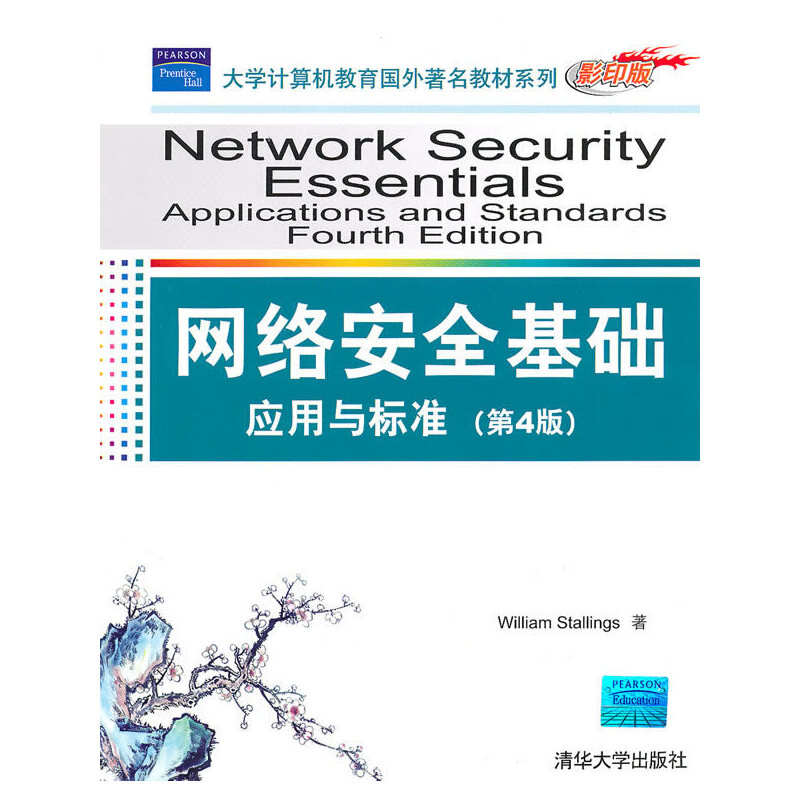网络安全基础:应用与标准(第4版) / 大学计算机教育国外著名教材系列(影印版)
¥46.00定价
作者: [美]William Stallings
出版时间:2016-01
出版社:清华大学出版社
- 清华大学出版社
- 9787302229728
- 1-3
- 23361
- 16开
- 2016-01
- 工学
- 计算机科学与技术
- TP393.08
- 计算机
内容简介
本书由著名作者William Stallings编写,以当今网络安全的实际解决方案为基础,既简明扼要,又全面系统地介绍了网络安全的主要内容,包括基本原理、重要技术、主要方法和重要的工业标准等。全书共包含11章。除第1章引言外,其余各章分为三大部分叙述:第一部分是密码学,重点介绍分组密码、流密码,消息认证码、安全杂凑函数、公钥密码和数字签名等的基本原理、主要方法和重要应用场景等,并简要介绍了几种常用的典型算法,包括DES算法、AES算法、RC4算法和RSA算法等;第二部分是网络安全应用,简要介绍了传输层安全中的SSL/TLS协议、无线局域网安全及WAP协议、电子邮件安全与PGP与SIM,ME协议、IP层安全与IPsec协议等。第三部分是系统安全,简要介绍了入侵检测与口令管理、恶意软件与防火墙等。
本书以*和实用的网络安全知识为主题,采用深入浅出的叙述手法,每章末尾还给出一定的推荐读物和思考练习题。因此,本书既是高等学校网络安全基础课程的好教材,也是工程技术人员和网络爱好者了解网络安全基本概貌的好读物。
本书以*和实用的网络安全知识为主题,采用深入浅出的叙述手法,每章末尾还给出一定的推荐读物和思考练习题。因此,本书既是高等学校网络安全基础课程的好教材,也是工程技术人员和网络爱好者了解网络安全基本概貌的好读物。
目录
Preface ix About the Author xiv Chapter 1 Introduction 1 1.1 Computer Security Concepts 3 1.2 The OSI Security Architecture 8 1.3 Security Attacks 9 1.4 Security Services 13 1.5 Security Mechanisms 16 1.6 A Model for Network Security 19 1.7 Standards 21 1.8 Outline of This Book 21 1.9 Recommended Reading 22 1.10 Internet and Web Resources 23 1.11 Key Terms, Review Questions, and Problems 25 PART ONE CRYPTOGRAPHY 27 Chapter 2 Symmetric Encryption and Message Confidentiality 27 2.1 Symmetric Encryption Principles 28 2.2 Symmetric Block Encryption Algorithms 34 2.3 Random and Pseudorandom Numbers 42 2.4 Stream Ciphers and RC4 45 2.5 Cipher Block Modes of Operation 50 2.6 Recommended Reading and Web Sites 55 2.7 Key Terms, Review Questions, and Problems 56 Chapter 3 Public-Key Cryptography and Message Authentication 61 3.1 Approaches to Message Authentication 62 3.2 Secure Hash Functions 67 3.3 Message Authentication Codes 73 3.4 Public-Key Cryptography Principles 79 3.5 Public-Key Cryptography Algorithms 83 3.6 Digital Signatures 90 3.7 Recommended Reading and Web Sites 90 3.8 Key Terms, Review Questions, and Problems 91 PART TWO NETWORK SECURITY APPLICATIONS 97 Chapter 4 Key Distribution and User Authentication 97 4.1 Symmetric Key Distribution Using Symmetric Encryption 98 4.2 Kerberos 99 4.3 Key Distribution Using Asymmetric Encryption 114 4.4 X.509 Certificates 116 4.5 Public-Key Infrastructure 124 4.6 Federated Identity Management 126 4.7 Recommended Reading and Web Sites 132 4.8 Key Terms, Review Questions, and Problems 133 Chapter 5 Transport-Level Security 139 5.1 Web Security Considerations 140 5.2 Secure Socket Layer and Transport Layer Security 143 5.3 Transport Layer Security 156 5.4 HTTPS 160 5.5 Secure Shell (SSH) 162 5.6 Recommended Reading and Web Sites 173 5.7 Key Terms, Review Questions, and Problems 173 Chapter 6 Wireless Network Security 175 6.1 IEEE 802.11 Wireless LAN Overview 177 6.2 IEEE 802.11iWireless LAN Security 183 6.3 Wireless Application Protocol Overview 197 6.4 Wireless Transport Layer Security 204 6.5 WAP End-to-End Security 214 6.6 Recommended Reading andWeb Sites 217 6.7 Key Terms, Review Questions, and Problems 218 Chapter 7 Electronic Mail Security 221 7.1 Pretty Good Privacy 222 7.2 S/MIME 241 7.3 DomainKeys Identified Mail 257 7.4 Recommended Reading and Web Sites 264 7.5 Key Terms, Review Questions, and Problems 265 Appendix 7A Radix-64 Conversion 266 Chapter 8 IP Security 269 8.1 IP Security Overview 270 8.2 IP Security Policy 276 8.3 Encapsulating Security Payload 281 8.4 Combining Security Associations 288 8.5 Internet Key Exchange 292 8.6 Cryptographic Suites 301 8.7 Recommended Reading and Web Sites 302 8.8 Key Terms, Review Questions, and Problems 303 PART THI~ SYSTEM SECURITY 305 Chapter 9 Intruders 305 9.1 Intruders 307 9.2 Intrusion Detection 312 9.3 Password Management 323 9.4 Recommended Reading andWeb sites 333 9.5 Key Terms, Review Questions, and Problems 334 Appendix 9A The Base-Rate Fallacy 337 Chapter 10 Malicious Soft-ware 340 10.1 Types of Malicious Software 341 10.2 Viruses 346 10.3 Virus Countermeasures 351 10.4 Worms 356 10.5 Distributed Denial of Service Attacks 365 10.6 Recommended Reading and Web Sites 370 10.7 Key Terms, Review Questions, and Problems 371 Chapter 11 Firewalls 374 11.1 The Need for Firewalls 375 11.2 Firewall Characteristics 376 11.3 Types of Firewalls 378 11.4 Firewall Basing 385 11.5 Firewall Location and Configurations 388 11.6 Recommended Reading andWeb Site 393 11.7 Key Terms, Review Questions, and Problems 394 APPENDICES 398 Appendix A Some Aspects of Number Theory 398 A.1 Prime and Relatively Prime Numbers 399 A.2 Modular Arithmetic 401 Appendix B Projects for Teaching Network Security 403 B.1 Research Projects 404 B.2 Hacking Project 405 B.3 Programming Projects 405 B.4 Laboratory Exercises 406 B.5 Practical Security Assessments 406 B.6 Writing Assignments 406 B.7 Reading/Report Assignments 407 Index 408 ONLINE CHAPTERS Chapter 12 Network Management Security 12.1 Basic Concepts of SNMP 12.2 SNMPvl Community Facility 12.3 SNMPv3 12.4 Recommended Reading and Web Sites 12.5 Key Terms, Review Questions, and Problems Chapter 13 Legal and Ethical Aspects 13.1 Cybercrime and Computer Crime 13.2 Intellectual Property 13.3 Privacy 13.4 Ethical Issues 13.5 Recommended Reading and Web Sites 13.6 Key Terms, Review Questions, and Problems ONLINE APPENDICES Appendix C Standards and Standards-Setting Organizations C.1 The Importance of Standards C.2 Internet Standards and the Internet Society C.3 National Institute of Standards and Technology Appendix D TCP/IP and OSI D.1 Protocols and Protocol Architectures D.2 The TCP/IP Protocol Architecture Do3 The Role of an Internet Protocol D.4 IPv4 D.5 IPv6 D.6 The OSI Protocol Architecture Appendix E Pseudorandom Number Generation E.1 PRNG Requirements E.2 PRNG Using a Block Cipher E.3 PRNG Using a Hash Function or Message Authentication Code Appendix F Kerberos Encryption Techniques E.1 Password-to-Key Transformation E.2 Propagating Cipher Block Chaining Mode Appendix G Data Compression Using ZIP G.1 Compression Algorithm G.2 Decompression Algorithm Appendix H PGP Random Number Generation H.1 True Random Numbers H.2 Pseudorandom Numbers Appendix I The International Reference Alphabet Glossary References








